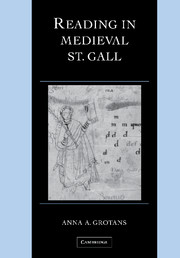Book contents
- Frontmatter
- Dedication
- Contents
- List of plates
- Acknowledgments
- List of abbreviations
- Manuscript punctuation and other symbols
- Introduction
- 1 Medieval reading
- 2 Education at ST. Gall
- 3 Language use and choice
- 4 The ST. Gall Tractate
- 5 Discretio in the classroom
- 6 Accentus
- 7 Spelling for reading
- Bibliography
- Index of manuscripts
- General index
- References
Bibliography
Published online by Cambridge University Press: 13 May 2010
- Frontmatter
- Dedication
- Contents
- List of plates
- Acknowledgments
- List of abbreviations
- Manuscript punctuation and other symbols
- Introduction
- 1 Medieval reading
- 2 Education at ST. Gall
- 3 Language use and choice
- 4 The ST. Gall Tractate
- 5 Discretio in the classroom
- 6 Accentus
- 7 Spelling for reading
- Bibliography
- Index of manuscripts
- General index
- References
- Type
- Chapter
- Information
- Reading in Medieval St. Gall , pp. 311 - 354Publisher: Cambridge University PressPrint publication year: 2006

